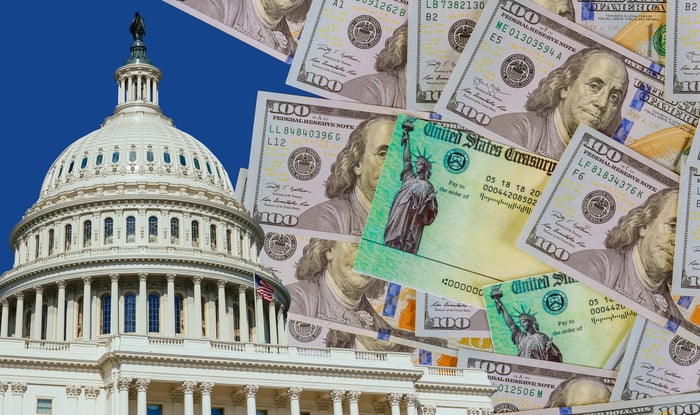Roughly three months ago, it was business as usual for the U.S. economy. Today, though, the U.S. economy and labor market are shells of what they once were due to the coronavirus disease 2019 (COVID-19) pandemic. The unemployment rate has rocketed higher to 14.7% -- a level not seen since the Great Depression -- with over 33 million people filing initial unemployment benefit claims within the past seven weeks.
Knowing full well what sort of havoc the shutdown of nonessential businesses would wreak on the economy and labor market, lawmakers passed and the president signed the Coronavirus Aid, Relief, and Economic Security (CARES) Act into law on March 27. This $2.2 trillion stimulus package is the largest relief bill in history, and it ultimately provided funding for hospitals, small business loans, distressed industries, and an expansion of the unemployment benefits program.

Image source: Getty Images.
Over 150 million Americans will qualify for an Economic Impact Payment
If there's one thing most Americans instantly think of when they hear the CARES Act mentioned, it's the $300 billion set aside for direct stimulus payments to the American public. Using a combination of adjusted gross income (AGI), tax-filing status, and citizenship status, the Internal Revenue Service (IRS) can quickly determine a person's eligibility for an Economic Impact Payment (as these stimulus payouts are officially known), as well as how much they'll receive.
As some of you are likely aware, the maximum stimulus payment is $1,200 per individual taxpayer or $2,400 for a married couple filing jointly. Additionally, qualifying dependent children under the age of 17 can add $500 per child to what a parent or household will receive. To net this maximum Economic Impact Payment, single, married, or head-of-household filers would need to have respective AGIs below $75,000, $150,000, and $112,500 in their most recent tax filings.
On the flip side, tens of millions of Americans won't receive a dime. This includes high-income earners, dependents aged 17 and older, and non-citizens without a Social Security number who have no legal pathway citizenship. What's a high-income earner? In the case of Economic Impact Payments, it's a single, married, or head-of-household filer with a respective AGI above $99,000, $198,000, and $136,500. Folks whose incomes fall between these upper and lower bounds are eligible for a reduced payout.

Image source: Getty Images.
Want your stimulus money faster? Then you'd better act quickly
All told, the Treasury Department has already paid out close to 130 million eligible Economic Impact Payment recipients, totaling around $218 billion, through May 8, 2020. However, this means at least 20 million-plus recipients are still waiting to receive their payments.
One thing the IRS and Treasury Department have strongly encouraged eligible individuals and couples to do to expedite the receipt of their payouts is to enter their bank account information online via the IRS's "Get My Payment" tool. Direct deposit payments, once processed, can reach an eligible recipients' bank account within a matter days.
By comparison, paper checks can take up to two weeks to reach their intended destination, and the IRS is doling out paper checks from the bottom up, in terms of earnings. In other words, folks with less than $10,000 in AGI will receive their payouts first, followed by tax filers with AGIs of up to $20,000, and so on. In total, it could take multiple months before all of the paper stimulus checks have been mailed out.
However, the time frame for eligible recipients to expedite the receipt of their Economic Impact Payment is waning. On Friday, May 8, the IRS announced that your last chance to enter your bank account information online in order to receive your stimulus money via direct deposit, rather than by paper check, will be at 12 p.m. EDT on Wednesday, May 13. That means there's just one more day (or perhaps even less by the time you're reading this) to visit the Get My Payment tool and enter your information.
Said IRS Commissioner Chuck Rettig:
We're working had to get more payments quickly to taxpayers. We want people to visit Get My Payment before the noon Wednesday deadline so they can provide their direct deposit information. Time is running out for a chance to get these payments several weeks earlier through direct deposit.

Image source: Getty Images.
My bank account info is correct, but I still don't have my stimulus payout
For those of you who have provided your bank account info and are still waiting for your stimulus money, this can be equally infuriating. Here are a handful of reasons you might still be waiting for your payout.
First of all, it could come down to something as simple as when you entered your bank account information online with the IRS. If you provide your bank account info for direct deposit prior to 12 p.m. EDT on a Tuesday, you'll be able to use the Get My Payment tool to check your payment date by the coming Saturday. Meanwhile, if you entered this information after noon EDT on Tuesday, then you'll have to wait until the following Saturday to find out your payment date.
Another consideration to make -- especially if you're receiving Social Security, Supplemental Security Income, or Veterans Affairs benefits -- is that your stimulus money will be received the same way these governmental benefits are paid out. Thus, if you're used to receiving a paper check, that's how these payments will be doled out. In many instances, your payment is likely on its way, but it could take an additional two weeks to arrive.
Perhaps the most common reason you haven't received your Economic Impact Payment yet is because you've used a tax-preparation service in recent years. Tax-prep services often create a temporary landing account for your tax refund, which allows them to pull out any fees and interest you might owe. They then forward what remains of your refund onto your bank account. There's a real possibility that millions of Americans' payouts could wind up in these temporary accounts. It happened to approximately 20 million people when stimulus checks were issued in 2008, and it may happen again this year.






